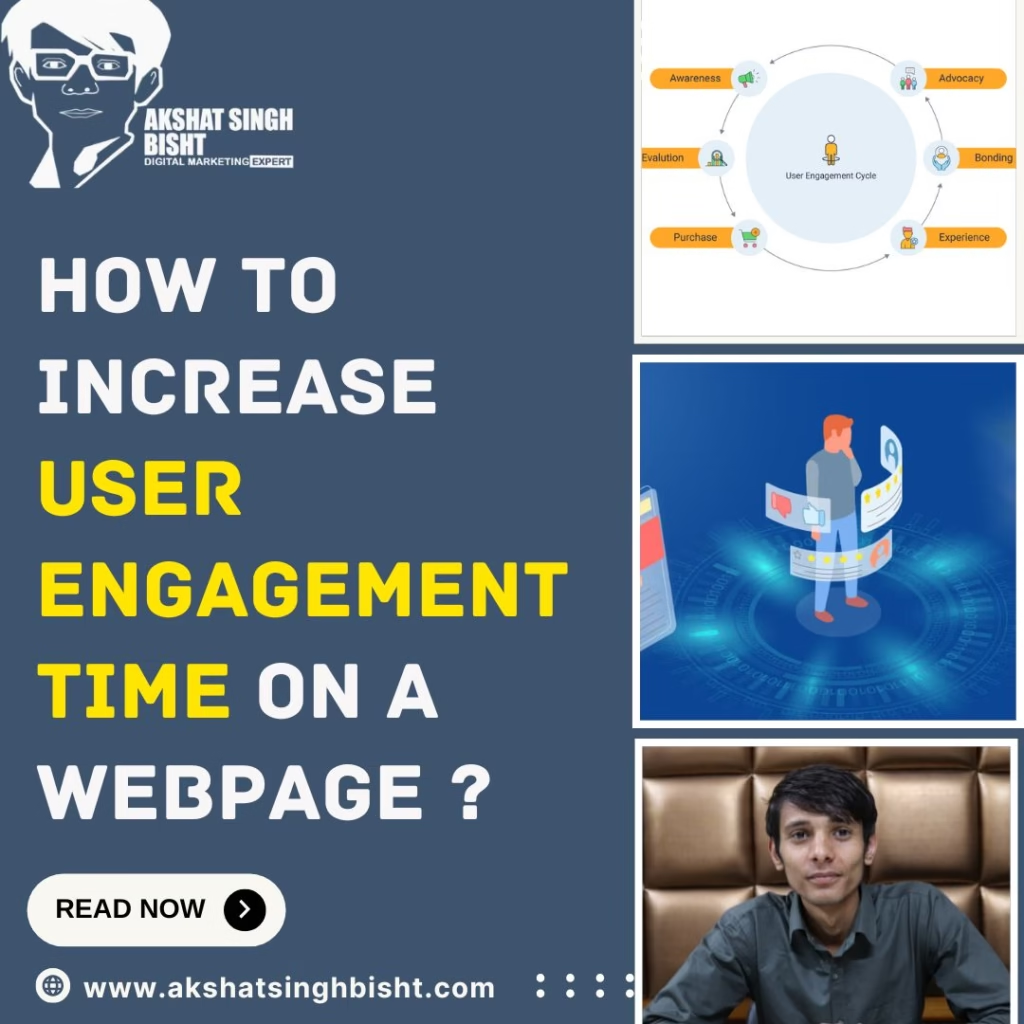In the realm of digital marketing, one of the most crucial metrics to track is user engagement time. This metric indicates how long visitors stay on your webpage, reflecting their interest and the value they perceive in your content. High engagement times can lead to lower bounce rates, higher conversion rates, and improved SEO rankings. Here’s an in-depth guide on strategies to increase user engagement time on your webpage.

User engagement time refers to the amount of time a visitor spends interacting with a webpage during a single session. It is a crucial metric in digital marketing and web analytics, as it provides insights into the effectiveness of a website’s content, layout, and overall user experience. High user engagement time often indicates that users find the content valuable, engaging, and relevant to their needs.
Understand Your Audience: Conduct thorough research to understand your audience’s needs, preferences, and pain points. Tailor your content to address these aspects.
Compelling Headlines: Craft headlines that grab attention and encourage clicks. Use power words and numbers to make them more enticing.
In-Depth Articles: Longer, comprehensive articles often perform better. Aim for a word count that thoroughly covers the topic without fluff.
Regular Updates: Keep your content fresh and up-to-date to maintain its relevance.
Clean Layout: Use a clean, visually appealing layout with ample white space. Avoid clutter and ensure a logical flow of information.
Easy Navigation: Implement intuitive navigation with a clear menu structure. Use breadcrumb trails to help users keep track of their location.
Mobile Optimization: Ensure your website is fully responsive and provides a seamless experience across all devices.
High-Quality Images: Use relevant, high-resolution images that complement your content.
Infographics: Visual representations of data can make complex information easier to understand and more engaging.
Videos: Incorporate videos to provide dynamic content that can capture and retain attention. Tutorials, explainer videos, and testimonials are effective options.
Interactive Elements: Use interactive elements like sliders, quizzes, and polls to engage users actively.
Slow-loading pages can deter users and increase bounce rates. Improve your page load speed by:
Optimizing Images: Compress images without compromising quality. Use modern formats like WebP.
Minimizing Code: Reduce the amount of JavaScript and CSS files. Minify and combine files to decrease HTTP requests.
Using Content Delivery Networks (CDNs): Distribute your content through CDNs to ensure faster delivery to users worldwide.
Leveraging Browser Caching: Enable caching to speed up load times for returning visitors.
Internal links guide users to related content on your website, keeping them engaged longer. Best practices include:
Contextual Linking: Link to relevant articles or pages within your content to provide additional value.
Clear Anchor Texts: Use descriptive anchor texts that clearly indicate the linked content.
Related Posts Widgets: Use widgets or plugins to display related posts at the end of articles.
Readable content encourages users to stay longer and absorb more information. Improve readability by:
Short Paragraphs: Break up long blocks of text into shorter, more manageable paragraphs.
Subheadings: Use subheadings to organize content and make it easier to scan.
Bullet Points and Lists: Use bullet points and numbered lists to present information clearly and concisely.
Readable Fonts: Choose fonts that are easy to read on all devices. Ensure appropriate font size and line spacing.
Effective CTAs guide users on the next steps and encourage deeper engagement. To create compelling CTAs:
Be Clear and Direct: Use straightforward language that tells users exactly what to do.
Create a Sense of Urgency: Use phrases that convey urgency, such as “Limited Time Offer” or “Act Now.”
Visually Stand Out: Design CTAs that are visually distinct from the rest of the content. Use contrasting colors and larger fonts.
Strategic Placement: Position CTAs where they are most likely to be seen, such as above the fold, within the content, and at the end of articles.
Social proof can build trust and encourage users to engage more with your content. Incorporate:
Testimonials: Display customer testimonials and reviews.
User-Generated Content: Showcase content created by your users, such as social media posts or blog comments.
Trust Badges: Use badges and certifications to highlight credibility and expertise.
Regularly analyze user behavior and engagement metrics to identify areas for improvement. Use tools like Google Analytics to track:
Average Session Duration: Measure the average time users spend on your site.
Bounce Rate: Identify pages with high bounce rates and investigate the causes.
Heatmaps: Use heatmaps to visualize user interactions and optimize content placement.
Based on your analysis, continuously optimize your content and website features to enhance user engagement.
Increasing user engagement time on your webpage requires a strategic and multifaceted approach. By focusing on high-quality content, improving website usability, incorporating engaging visuals, optimizing load speeds, and leveraging internal linking, you can create a more engaging and enjoyable user experience. Additionally, enhancing readability, using effective CTAs, showcasing social proof, and continuously analyzing and optimizing your site will help retain visitors and drive better overall performance. Implement these strategies to ensure that your website not only attracts visitors but also keeps them engaged and coming back for more.
Akshat’s passion for marketing and dedication to helping others has been the driving force behind AkshatSinghBisht.com. Known for his insightful perspectives, practical advice, and unwavering commitment to his audience, Akshat is a trusted voice in the marketing community.
If you have any questions simply use the following contact details.